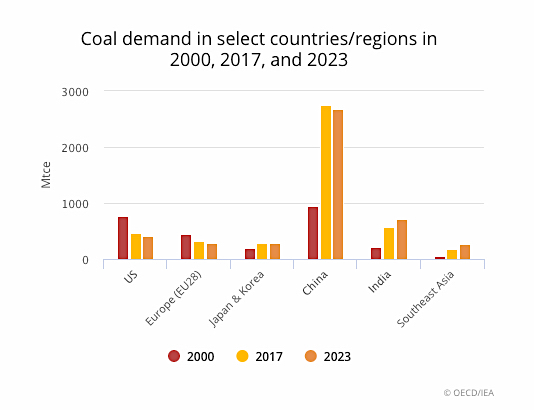
After two years of decline and despite growing pressure from environmentalists, coal consumption is expanding, driven by “strong” fuel burning in China and India, the latest report from the International Energy Agency (IEA) shows.
According to the Paris-based body, coal consumption will rise by an average of 0.2% a year from 5,355 million tonnes of coal equivalent (Mtce) in 2017 to 5,418 Mtce in 2023. This is because falling demand in western Europe and North America is likely to be offset by increased demand in a host of Asian countries, including China, India, Indonesia and Vietnam, the report reads.

Taken from: IEA — Coal 2018 Report.
“Despite significant media attention being given to divestments and moves away from coal, market trends are proving resistant to change,” states the report.
In a growing number of countries, the agency says, the elimination of coal-fired generation is a key climate policy goal. In others, coal remains the preferred source of electricity and is seen as abundant and affordable.
While coal remains the second-largest global source of primary energy, behind oil, the EIA says cheap, cleaner-burning natural gas and renewable energy sources continue to eat into coal’s share of the global energy mix.
By 2023, it expects coal to provide 25% of the world’s energy, down from 27% currently.

Taken from: IEA — Coal 2018 Report.
Miners, however, should brace for another period of slow growth as current high prices for coal are not leading to investments in new mines. The IEA attributes that to local opposition and policies aimed at combating climate change creating uncertainty about future demand.
“Banks, insurance companies, hedge funds, utilities and other operators in advanced economies are exiting the coal business,” the agency says. “In many parts of the world, growing opposition to coal projects has provided strong disincentives for investors.”
The IEA’s forecast comes days after nearly 200 countries agreed to rules for implementing a landmark climate deal aimed at curbing emissions from fossil fuels.